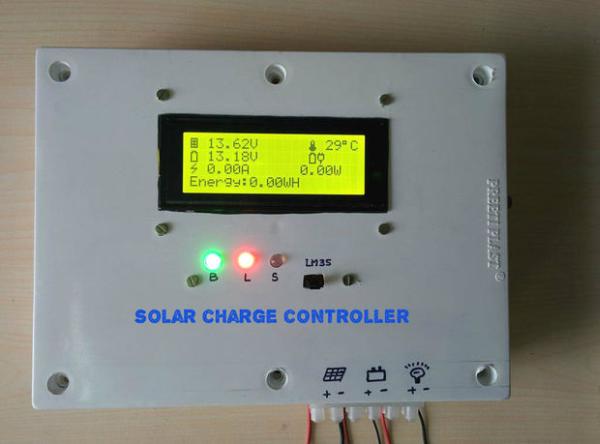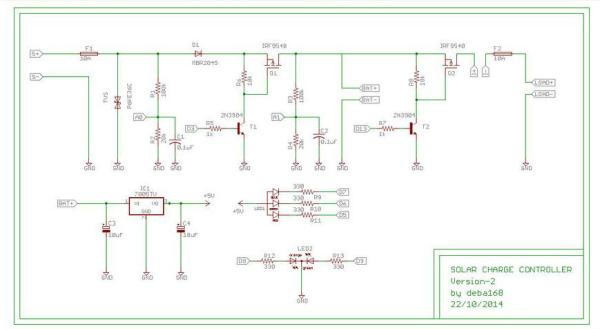One year ago, I began building my own solar system to provide power for my village house.Initially I made a LM317 based charge controller and an Energy meter for monitoring the system.Finally I made PWM charge controller.In April-2014 I posted my PWM solar charge controller designs on the web,it became very popular. Lots of people all over the world have built their own. So many students have made it for their college project by taking help from me.I got several mails every day from people with questions regarding hardware and software modification for different rated solar panel and battery. A very large percentage of the emails are regarding the modification of charge controller for a 12Volt solar system.

You can see my old version charge controller here
To solve this problem I made this new version charge controller so that any one can use it without changing the hardware and software. I combine both the energy meter and charge controller in this design.
Why I need a 3D printer ?
You can see in each of my project, I worked hard to make a good enclosure.After spending so much time the outcome is not so exciting.I think I can make a good enclosure by a 3D printer.But the problem is that I am residing in a place where there is no access to 3D printer. It is expensive also which is not affordable by me.So I participate in 3 competitions to get it.If I will won a 3D printer then I will make my project better and better in future.Now I am tryiing to learn 123D which may helps to work in 3D printer.
So I request you please vote for me.
Thanks in advance
Specification of version-2 charge controller :
1.Charge controller as well energy meter
2. Automatic Battery Voltage Selection (6V/12V)
3.PWM charging algorithm with auto charge set point according to the battery voltage
4.LED indication for the state of charge and load status
5. 20×4 character LCD display for displaying voltages,current,power,energy and temperature.
6.Lightning protection
7.Reverse current flow protection
8.Short Circuit and Over load protection
9. Temperature Compensation for Charging
Electrical specifications :
1.Rated Voltage= 6v /12V
2.Maximum current = 10A
3.Maximum load current =10A
4.Open Circuit Voltage = 8-11V for 6V system /15 -25V for 12V system
Step 1: Parts and Tools Required :
Parts:
1.Arduino Nano ( eBay)
2.P-MOSFET (IRF 9540 x2 )
3.Power diode (MBR 2045 for 10A and IN5402 for 2A)
4.Voltage Regulator (LM7805)
5.Temperature Sensor(LM35)
6.Current Sensor (ACS712)
7.TVS diode (P6KE36CA)
8.Transistors ( 2N3904 or 2N2222)
9.Resistors( 100k x 2, 20k x 2,10k x 2,1k x 2, 330ohm x 5)
10.Ceramic Capacitors (0.1uF x 2)
11.Electrolytic Capacitors ( 100uF and 10uF)
12. 20×4 I2C LCD (eBay)
13.RGB LED (ebay)
14.Bi Color LED
15.Jumper Wires/Wires(eBay)
16.Header Pins (Male,Female and right angle)
17.Heat Sink (eBay)
18.Fuse Holder and fuses (eBay)
19.Push Button
20.Perforated Board (eBay)
21.Project Enclosure
22.Screw terminals ( 3x 2pin and 1×6 pin)
23.Nuts/Screws/Bolts
24.Plastic Base
Tools :
1.Soldering Iron
2.Wire Cutter and Stripper
3.Screw Driver
4.Drill
5.Dremel
6.Glue Gun
7.Hobby Knife
Step 2: How The Charge Controller Works :
The heart of of the charge controller is Arduino nano board.The arduino MCU senses the solar panel and battery voltages.According to this voltages it decides how to charge the battery and control the load.
The amount of charging current is determined by difference between battery voltage and charge set point voltages. The controller uses two stages charging algorithm.According to the charging algorithm it gives a fixed frequency PWM signal to the solar panel side p-MOSFET. The frequency of PWM signal is 490.20Hz(default frequency for pin-3). The duty cycle 0-100% is adjusted by the error signal.
The controller gives HIGH or LOW command to the load side p-MOSFET according to the dusk/dawn and battery voltage.
The full schematic is attached bellow.
![]() charge controller version -2.pdf18 KB
charge controller version -2.pdf18 KB
Step 3: Main functions of solar charge controller:
The charge controller is designed by taking care of the following points.
1.Prevent Battery Overcharge: To limit the energy supplied to the battery by the solar panel when the battery becomes fully charged.This is implemented in charge_cycle() of my code.
2.Prevent Battery Over discharge: To disconnect the battery from electrical loads when the battery reaches low state of charge.This is implemented in load_control() of my code.
3.Provide Load Control Functions: To automatically connect and disconnect an electrical load at a specified time. The load will ON when sunset and OFF when sunrise.This is implemented in load_control() of my code.
4.Monitoring Power and Energy : To monitor the load power and energy and display it.
5.Protect from abnormal Condition: To protect the circuit from different abnormal situation like lightening,over voltage,over current and short circuit etc.
6.Indicating and Displaying: To indicate and display the various parameters
7.Serial Communication: To print various parameters in serial monitor
Step 4: Sensing Voltages,Current and temperature :
1.Voltage Sensor:
The voltage sensors are used to sense the voltage of solar panel and battery.It is implemented by using two voltage divider circuits.It consists of two resistors R1=100k and R2=20k for sensing the solar panel voltage ans similarly R3=100k and R4=20k for battery voltage.The out put from the R1and R2 is connected to arduino analog pin A0 and out put from the R3 and R4 is connected to arduino analog pin A1.
2.Current Sensor :
The current sensor is used for measuring the load current.later this current is used to calculate the load power and energy.I used a hole effect current sensor (ACS712-20A)
3.Temperature Sensor :
The temperature sensor is used to sense the room temperature. I used LM35 temperature sensor which is rated for −55°C to +150°C Range.
Why Temperature monitoring is Required ?
The battery’s chemical reactions change with temperature.As the battery gets warmer, the gassing increases. As the battery gets colder,it becomes more resistant to charging. Depending on how much the battery temperature varies, it is important to adjust the charging for temperature changes.So it is important to adjust charging to account for the temperature effects. The temperature sensor will measure the battery temperature, and the Solar Charge Controller uses this input to adjust the charge set point as required.The compensation value is – 5mv /degC/cell for lead acid type batteries.(–30mV/ºC for 12V and 15mV/ºC for 6V battery).The negative sign of temperature compensation indicates,increase in temperature require a reduction in charge set point.
For more details on Understanding and Optimizing Battery Temperature Compensation
Step 5: Sensors Callibration
Voltage Sensors :
5V = ADC count 1024
1 ADC count = (5/1024)Volt= 0.0048828Volt
Vout=Vin*R2/(R1+R2)
Vin = Vout*(R1+R2)/R2 R1=100 and R2=20
Vin= ADC count*0.00488*(120/20) Volt
Current Sensor:
As per seller information for ACS 712 current sensor
Sensitivity is = 100mV / A =0.100V/A
No test current through the output voltage is VCC / 2= 2.5
ADC count= 1024/5*Vin and Vin=2.5+0.100*I (where I=current)
ADC count= 204.8(2.5+0.1*I) =512+20.48*I
=> 20.48*I = (ADC count-512)
=> I =(ADC count/20.48)- 512/20.48
Current (I) =0.04882*ADC -25
Temperature Sensor :
As per data sheet of LM35
Sensitivity=10 mV/°C
Temp in deg C =(5/1024)*ADC count*100
Note : The sensors are calibrated by assuming the arduino Vcc= 5V reference.But in practical it is not 5V always.So there may be chance of getting wrong value from the actual value.It can be solved by following way.
Measure the voltage between arduino 5V and GND by a multimeter.Use this voltage instead of 5V for Vcc in your code.Hit and try to edit this value until it matches the actual value.
Example: I got 4.47V instead of 5V.So the change should be 4.47/1024=0.0043652 instead of 0.0048828.
For more detail: ARDUINO SOLAR CHARGE CONTROLLER ( Version 2.0)

